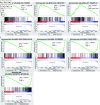Integrated pan-cancer analysis revealed therapeutic targets in the ABC transporter protein family
- PMID: 40445912
- PMCID: PMC12124511
- DOI: 10.1371/journal.pone.0308585
Integrated pan-cancer analysis revealed therapeutic targets in the ABC transporter protein family
Abstract
Next-generation sequencing technology enables uniform and impartial assessment of cancer diagnoses and prognosis. However, such studies are mostly type-specific, and capturing shared genomic abnormalities responsible for neoplastic transformation and progression is a challenging task. Pan-cancer analysis offers insights into the shared and unique molecular mechanisms driving cancer. We conducted an integrated gene-expression analysis using 10,629 samples from 30 distinct cancer types characterized by The Cancer Genome Atlas (TCGA). A gene co-expression network was constructed and genes overlapping between the selected modules and Differentially Expressed Genes (DEGs) were designated as genes of interest. Following a comprehensive literature review, ATP binding cassette subfamily A member 10 (ABCA10) and ATP binding cassette subfamily B member 5 (ABCB5) were selected as key candidates for downstream analysis due to the absence of systematic pan-cancer analysis of these genes. This study presents a unique contribution as the first comprehensive pan-cancer analysis of ABCA10 and ABCB5, highlighting their roles in tumor biology and clinical outcomes. We employed a variety of bioinformatics tools to explore the role of these genes across different tumors. Our research demonstrated that ABCA10 shows reduced expression, while ABCB5 displays variable expression patterns across tumors, indicating their opposing roles and flexible functions in pan-cancer. In many cancer patients, these expression patterns are correlated with worse survival outcomes. Furthermore, immunotherapy responses and immune infiltration across a variety of tumor types are associated with the expression levels of both ABCA10 and ABCB5. These results imply that ABCA10 and ABCB5 could serve as valuable predictive markers and potential therapeutic targets across various cancers.
Copyright: © 2025 Masood et al. This is an open access article distributed under the terms of the Creative Commons Attribution License, which permits unrestricted use, distribution, and reproduction in any medium, provided the original author and source are credited.
Conflict of interest statement
The authors have declared that no competing interests exist.
Figures









Similar articles
-
Profiling of ABC transporters ABCB5, ABCF2 and nestin-positive stem cells in nevi, in situ and invasive melanoma.Mod Pathol. 2012 Aug;25(8):1169-75. doi: 10.1038/modpathol.2012.71. Epub 2012 May 4. Mod Pathol. 2012. PMID: 22555176
-
Downregulation of ATP binding cassette subfamily a member 10 acts as a prognostic factor associated with immune infiltration in breast cancer.Aging (Albany NY). 2022 Mar 5;14(5):2252-2267. doi: 10.18632/aging.203933. Epub 2022 Mar 5. Aging (Albany NY). 2022. PMID: 35247251 Free PMC article.
-
The BET inhibitor JQ1 suppresses tumor survival by ABCB5-mediated autophagy in uveal melanoma.Cell Signal. 2025 Jan;125:111483. doi: 10.1016/j.cellsig.2024.111483. Epub 2024 Oct 22. Cell Signal. 2025. PMID: 39442901
-
Multidrug resistance: retrospect and prospects in anti-cancer drug treatment.Curr Med Chem. 2006;13(16):1859-76. doi: 10.2174/092986706777585077. Curr Med Chem. 2006. PMID: 16842198 Review.
-
Multidrug resistance: molecular mechanisms and clinical relevance.Cancer Chemother Pharmacol. 1997;40 Suppl:S3-8. doi: 10.1007/s002800051053. Cancer Chemother Pharmacol. 1997. PMID: 9272126 Review.
References
-
- World Health Organization. Fact sheet: Cancer; 2022. Available from: https://www.who.int/news-room/fact-sheets/detail/cancer
-
- Nature Genetics. Taking pan-cancer analysis global; 2013. - PubMed
MeSH terms
Substances
LinkOut - more resources
Full Text Sources
Medical

